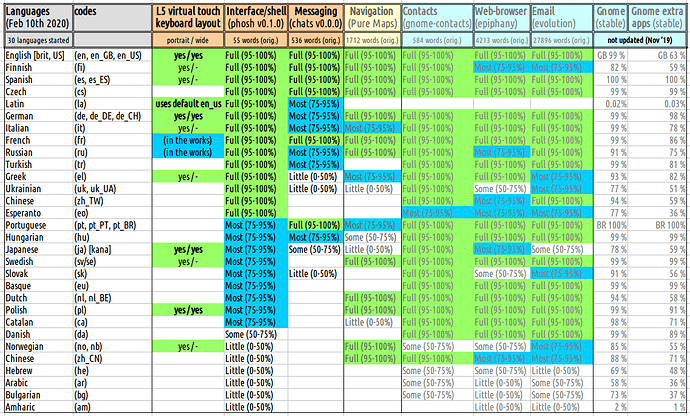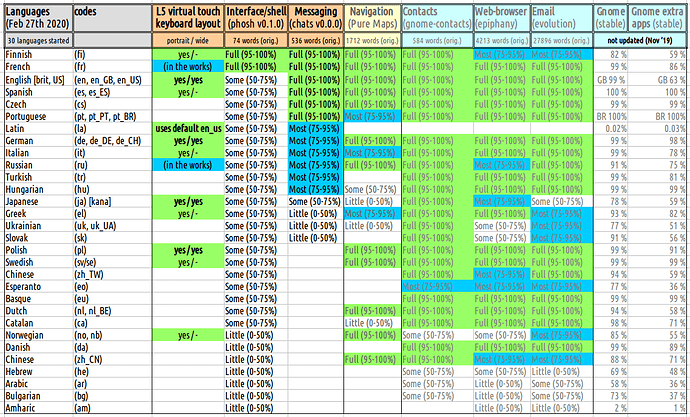Sooo… I started to write this several times over past some weeks but stuff happened and now it’s end of July. When the change happened, I didn’t have time to jump right in and now I’m playing catch up. My initial text went a bit long, so here is the portion similar to that what I’ve tried to do previously – to track what’s going on with the translations.
Current situation: stats and overview
So, the translations have mostly ground to a halt, it seems. When Zanata service became unreliable and the whole management of those language files was moved to Damned Lies (DL, https://l10n.gnome.org). Ironically, yesterday when I was preparing this, I noticed that it was having bad times, but that was resolved in a couple of hours.
Now, I’d like to point out that the move effectively gave a new home to managing the translation files but at the same time it took away the tools to translate – a necessary move if you’re looking at this from coder’s perspective but a big step backwards if you are only doing translations. From what I’ve been able to find out in my limited searches (https://source.puri.sm/Librem5/phosh/-/merge_requests?scope=all&utf8=✓&state=merged&search=translation), only few active people have known a way to push their translation updates onward in the process. This was probably because they’re familiar with how development and git work. For the rest of us, there are plenty of guides and help at DL for the general stuff and from Gnome dev perspective. But they do not cover everything and the breadcrumbs/explanation/path from L5 forums to to translations to merge (the final step to actually include the translation into the app) is missing. With some of that I’ll try to help out in a separate posting in a day or two. There’s a lot more to say there and I want to keep that separate from this stats and situation overview.
Returning to the point, the change happened and I’d have to say some follow-through is still waited on. Many languages are where they were left at Zanata, several months ago. But it’s not all bad. There has been work done by active individuals: Romanian, Ukrainian, Catalan and Danish have to be mentioned – keep up the good work. A couple of others have tried to be activate too, but have not been directed towards being considered to be merged yet, it seems.
As a new thing to most, please notice a new app to translate. In addition to phosh and chatty/chatts , we now have calls in DL. At some point, if memory serves, at least keyboard and documentation should also be expected to appear for translation, and likely some other apps too.
The excellent thing about DL is, that it has good public statistics on how much translation has been done – both relative percentages and absolute numbers of strings. So, no more manually collected tables here. I did gather a bit of an overview of them, though, as well as Pure Maps (which is on Transifex.com and not DL).
chatty/chatts: https://l10n.gnome.org/module/chatty/
- strings: 180 (538 words)
- languages started: 21 languages/locales, of them 6 are active and fully (over 95%) translated
- notes: more languages should start this but translation levels are pretty good
- last update: couldn’t tell you at the moment, as they’ve not been announced (maybe a few months back?)
phosh: https://l10n.gnome.org/module/phosh/
- strings: 44 (100 words)
- languages started: 36 languages/locales, of them 7 are active and fully (over 95%) translated
- notes: mpst languages are unchanged and getting worse, as more strings have been added/updated
- last update: couldn’t tell you at the moment, as they’ve not been announced (maybe a few months back?)
calls: https://l10n.gnome.org/module/calls/
- strings: 40 (104 words)
- languages started: 13 languages/locales, of them 6 are active and fully (over 95%) translated
- notes: more languages should start this but translation levels are pretty good of those that have started
- last update: couldn’t tell you at the moment, as they’ve not been announced (maybe a few months back?)
- [edit to add] for reference, it takes about 45 minutes to do the translation file (slow-ish pace)
pure maps: https://www.transifex.com/rinigus/
- strings: 469 (1921 words)
- languages: 23 languages/locales started, of them 10 are active and fully (over 95%) translated
- notes: for more, there is also the related OSM Scout server that can be used to have your own map services (483 strings, 3976 words, 11 of 13 languages seem active and more would be welcome)
- last update: a couple of months ago (server seems steady, rarely updates)
- [edit: adding @rinigus here - maybe could get some comment from app developers perspective on translations and translating etc.]
Should there be some other app somewhere that should be kept on eye on (we’ll see how much effort tracking those needs)? Preferably something that’s going to be central to L5 experience. The ones that I previously had listed:
Librem 5 related translations combined tracking (all Purism L5 apps, now called “release set”) can be seen in https://l10n.gnome.org/releases/librem5/ It seems a bit “harsh” as a meter, as it calculates all apps and percentages equally – good activity in some doesn’t mean much if another app is neglected. All in all, there are 37 different locales (counting all languages and their separate regional codes) that have started work on one L5 app or another.
I won’t include the virtual keyboard layout situation here (maybe @dcz could comment on that), but just as a reminder, localization of keyboard layouts needs native users to define what is their preferred layout (see: https://developer.puri.sm/projects/squeekboard/tutorial.html).
At the forum (Where is the most interest in Linux phones?), @amosbatto did (again) a longer forum article on where the L5 had been searched and in which countries there was indication of interest towards it. This is valuable for internationalization efforts, as it tells (a) which languages are the ones that should be translated, and (b) which language areas need more hype and translations for them to get interested – it works both ways.
And if you are interested in the shortcomings of, and fixes to, Damned Lies, just this coming Monday evening (27.7.) there is an online seminar (https://events.gnome.org/event/19/) at GUADEC 2020 (Gnome’s biggest yearly conference). I’m not sure if I can make it, so if someone here does, it would be nice to see a couple of notes.
I’ll try see if I can edit a readable text about how to do L5 work with DL, and the differences to previous, to help anyone interested to continue the work.


 to low percentages in translations as phosh translationfiles in Zanata just updated
to low percentages in translations as phosh translationfiles in Zanata just updated  with several entries - it might take you all of 20 minutes to do them all
with several entries - it might take you all of 20 minutes to do them all  . It should be suggested that updates should be done soon / this week
. It should be suggested that updates should be done soon / this week  , as the server and service is
, as the server and service is 
 and no one want’s to have last minute translations go missing due to the move
and no one want’s to have last minute translations go missing due to the move 

